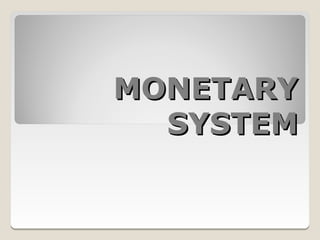
MONETARY SYSTEM: A HISTORY
- 3. Monetary System Relationship between monetary system and foreign exchange rates Historical development Fixed vs floating exchange rates Role of the IMF and World Bank Implications for managers
- 4. International Monetary System Currency exchange rates depend on the structure of the international monetary system In 2003 of all IMF members currencies ◦ Only 19% were free floating ◦ 25% were managed float ◦ 8% were adjustable peg ◦ 22% were fixed peg ◦ 4% were fixed by a currency board ◦ 22% were not currency of their own (use Euro, US Dollar)
- 6. Evolution of the International Monetary System GoldStandard: currencies pegged to gold value ◦ Convertibility guaranteed ◦ By 1880 most on gold standard ◦ Balance of trade equilibrium for all countries Value of exports should equal value of imports Flow of gold used to make up differences ◦ Abandoned in 1914 Failed resumption after WWI Great Depression
- 7. Bretton Woods (1944 - 1973) 44 countries met to design a new system in 1944 Established: International Monetary Fund (IMF) and World Bank ◦ IMF: maintain order in monetary system ◦ World Bank: promote general economic development ◦ Fixed exchange rates pegged to the US Dollar ◦ US Dollar pegged to gold at $35 per ounce ◦ Countries maintained their currencies ± 1% of the fixed rate; buy/sell own currency to maintain level
- 8. The Role of the IMF IMF maintained exchange rate ◦ discipline National governments had to manage inflation through their money supply ◦ flexibility Provides loans to help members states with temporary balance-of-payment deficit; ◦ Allows time to bring down inflation ◦ Relieves pressures to devalue Excessive drawing from IMF funds came with IMF supervision of monetary and fiscal policies ◦ Allowed to 10% devaluations and more with IMF approval 187 members by 2003
- 9. The Role of the World Bank WorldBank (IBRD) role (International Bank for Reconstruction & Development) ◦ Refinanced post-WWII reconstruction and development ◦ Provides low-interest long term loans to developing economies TheInternational Development Agency (IDA), an arm of the bank created in 1960 ◦ Raises funds from member states ◦ Loans only to poorest countries ◦ 50 year repayment at 1% per year interest
- 10. Collapse of Bretton Woods Devaluation pressures on US dollar after 20 years ◦ Lyndon Johnson policies Vietnam war financing Welfare program financing ◦ Nixon ended gold convertibility of US dollar in 1971 ◦ US dollar was devalued and dealers started speculating against it for further devaluation ◦ Bretton Woods fixed exchange rates abandoned in January 1972
- 11. Jamaica Agreement 1976 Floating rates declared acceptable Gold abandoned as reserve asset; ◦ IMF returned gold reserves to members at current prices ◦ Proceeds placed in trust fund to help poor nations ◦ IMF quotas – member country contributions – increased; membership now 182 countries ◦ Less-develop, non-oil exporting countries given more access to IMF IMF continued its role of helping countries cope with macroeconomic and exchange rate problems
- 12. Case for Floating Exchange Rates ◦ Monetary policy autonomy ◦ Trade balance adjustments helped The Case for Fixed Exchange Rates ◦ Monetary discipline ◦ Speculation limited ◦ Uncertainty reduced ◦ Trade balance adjustment effects on inflation controlled Who is right?
- 13. Recent Activities and the IMF Mexican Crisis 1995 Russian Ruble crisis1995 Asian crisis 1997/1998 ◦ Events The investment boom Excess capacity The debt bomb Expanding imports The crisis How does the IMF achieve results? ◦ Inappropriate policies? ◦ Moral Hazard? ◦ Lack of accountability?
- 14. Managerial Implications Currency management ◦ Currency market does not always work as expected ◦ Government intervention ◦ Speculative activity Business strategy ◦ Movements in exchange rates are difficult to predict ◦ Forward market is imperfect predictor of exchange rate movements ◦ Forward exchange rate market covers risk for months not years ◦ Maintenance of strategic flexibility required Disperse manufacturing Outsource ◦ Corporate-government relations
Hinweis der Redaktion
- This is a test
